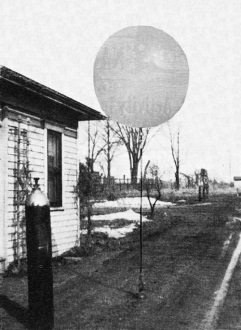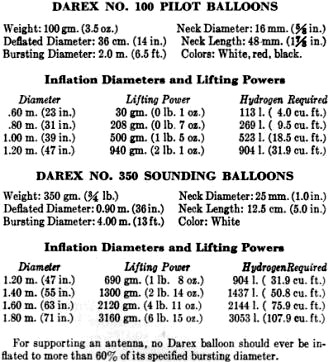|
November 1940 QST
 Table of Contents Table of Contents
These articles are scanned and OCRed from old editions of the ARRL's
QST magazine. Here is a list of the QST articles I have already
posted. All copyrights are hereby acknowledged. |
Kite- and balloon-lifted antennas are
very popular in the amateur radio realm. They are primarily used for short-term
activity such as during a contest or during an emergency; however, some operators
use them on a more extended basis. A really good series of articles on the use of
balloons and kites for suspending antennas can be found at
qsl.net/g4vgo/antenna1.htm.
Equations for calculating necessary balloon and kite sizes and predicting wind effects
are included along with lists of 'Dos' and 'Don'ts.' This is not a new phenomenon.
A 1940 edition of QST magazine described how to employ weather and sounding
balloons to provide needed antenna configurations in places where suitable permanent
structures were not available. Those balloons were intended to support antennas
for extended periods of time - measured in weeks rather than hours. Here is a
Short-Wave Craft article titled "Balloons Raise Shortwave Antenna."
More on Balloon-Supported Antennas

A balloon "sky hook" inflated and ready to take the antenna upstairs
for a week or so. The hydrogen tank is in the left foreground.
Practical Dope on a Practical Sky Hook
By R. Carleton Greene,* W8PWU
Recently, there has been a great deal of interest by most amateurs in balloon-supported
antennas. Many recognize the advantages of having a vertical antenna, and a balloon
seems about the most inexpensive means of obtaining one. Such an antenna is particularly
advantageous on the low-frequency bands, where most amateurs are unable to obtain
proper antenna heights. One might say that, in the balloon-supported antenna, we
have the proverbial "sky hook" which many have dreamed of to stick up in the air
and attach an antenna to. A limited number of amateurs are using balloon-supported
antennas at the present time, while many have expressed their desire to try one
providing they knew where to get the balloons and the gas to inflate them.
At the present time, there are two types of balloons suitable for supporting
antennas, although the balloons are designed primarily for meteorological purposes.
One type is the sounding balloon which was developed primarily for carrying radiosonde
(radio meteorograph). The other type is known as a pilot balloon and is used to
measure the direction and velocity of the wind. The Darex No. 350 Sounding Balloon
and the Darex No. 100 Pilot Balloon are the two balloons most suitable for amateur
purposes. These balloons are a product of The Dewey and Almy Chemical Company of
Cambridge B, Massachusetts. The balloons are made of pure latex rubber, assuring
maximum strength, elasticity and aging qualities. The great strength of such rubber
makes it possible to build the balloons with very thin walls, thus assuring balloons
of the greatest possible lightness, in which hydrogen or helium can be used for
net lifting power rather than for carrying the dead weight of the balloons themselves.
However, care should be exercised in handling these balloons because of their thin
wall structure. The inflation diameters, lifting powers and other data on these
balloons is to be found in the table. Greater lifting powers can be obtained by
using a cluster of balloons. The Darex No. 100 Balloon sells for less than a dollar,
while the cost of the larger Darex No. 350 Balloon is slightly under three dollars.
For more purposes, the Darex No. 100 Balloon is the more desirable, since it has
sufficient lifting power, requires less gas for inflation, and its cost is much
less than the larger one.
Hydrogen or helium for the balloons can be purchased in various sizes of refillable
cylinders ranging in capacity from twenty to one hundred eighty cubic feet. Hydrogen
costs between two and fifteen cents per cubic foot, depending upon the quantity
of gas purchased. Helium costs between seventeen and thirty cents per cubic foot,
.so its cost is prohibitive for most amateurs. When a cylinder of gas is purchased,
some companies loan the cylinder free for a period of thirty days, after which time
there is a rental fee of around two cents per day. Possibly some amateurs have the
facilities so that they can manufacture their own gas. If so, it might be said here
that the balloons will inflate fully under a pressure of 13 mm. (1/2 in.) of water.
The local welding company can tell you where hydrogen can be obtained.
If hydrogen is used, great care should be exercised in the inflation of these
balloons, as the gas is highly explosive. The balloon should be inflated out of
doors, and all lighted cigarettes, flames, or sparks of any kind should be kept
at a good distance from the balloon. Sparks from static electricity can be guarded
against by grounding the tank during inflation of the balloon. After inflation,
the neck of the balloon can be closed by folding it lengthwise and then taking a
pipe cleaner, folded double, and twisting it around the neck of the balloon with
a pair of pliers. If pipe cleaners are not available, No. 18 solid hook-up wire
will serve the purpose. It is advisable to use several seals in order to prevent
escape of the gas from the balloon. The ends of the wire seals should be trimmed
to prevent puncturing of the balloon.
The most desirable antenna wire for attachment to such a balloon is phosphor-bronze
fish line which is very light, strong, a good conductor and will not stretch. No.
18 or No. 20 hard-drawn copper wire also makes an excellent antenna. The writer
has also used 1/16 inch galvanized steel cable with excellent results. If the antenna
is to be very long, either the fish line or the hard-drawn copper wire is recommended,
since the steel cable is much heavier. A 135-foot length of 1/16 inch steel cable
weighs a little less than 3/4 of a pound, yet is easily carried aloft by a Darex
No. 100 balloon inflated to a diameter of a little over three and a half feet. The
antenna is attached to the balloon by tying the antenna around the neck of the balloon,
which is made of much heavier rubber than the body of the balloon. The manufacturer
claims the safe load on the neck of any single balloon to be about 2500 gm. (5 lb.
8 oz.)
Balloon-supported antennas are far from impractical for the amateur, as this
story points out. It also gives the complete dope on lifting powers of various balloons
and tells how to keep them from swaying too much in the breeze.
 The functioning of the balloon-supported
antenna will depend largely upon the length of antenna used. A half wave will probably
be found most satisfactory when there is no wind. In breezes the antenna will not
be perfectly vertical, in which case a longer antenna may be desirable in order
to obtain the proper angle of radiation. A small reel could be connected on the
station end of the antenna so that the length of the antenna could be changed, and
this would provide for use of the antenna on several bands. Although most amateurs
use a single piece of wire for an antenna, there is the possibility of using various
arrays. Several half waves could be stacked one above the other and a coil and condenser
in parallel used between each half wave section for phasing. This would give us
a Franklin antenna. Broadside arrays could also be used and information on these
various types of antennas may be found in the A.R.R.L. Antenna Book. The functioning of the balloon-supported
antenna will depend largely upon the length of antenna used. A half wave will probably
be found most satisfactory when there is no wind. In breezes the antenna will not
be perfectly vertical, in which case a longer antenna may be desirable in order
to obtain the proper angle of radiation. A small reel could be connected on the
station end of the antenna so that the length of the antenna could be changed, and
this would provide for use of the antenna on several bands. Although most amateurs
use a single piece of wire for an antenna, there is the possibility of using various
arrays. Several half waves could be stacked one above the other and a coil and condenser
in parallel used between each half wave section for phasing. This would give us
a Franklin antenna. Broadside arrays could also be used and information on these
various types of antennas may be found in the A.R.R.L. Antenna Book.
The balloon should remain aloft for a week or so, providing the balloon has been
handled carefully and the neck of the balloon properly sealed. Weather conditions
will also affect the length of time one will remain aloft. If the balloon has been
handled with greasy hands, the grease should be wiped off and talcum powder shaken
on these spots. If this is not done, the grease will hold heat and cause the balloon
to blister in these spots and this in turn will weaken the balloon. Broken balloons
may be traced to this or over-inflation, failing to allow for expansion in the sun.
For supporting an antenna, no Darex balloon should ever be inflated to more than
60% of its specified bursting diameter.
The balloon-supported antenna offers a wonderful field of experimentation and
should also be of interest to emergency corps. The balloons can be obtained in sealed
cylindrical cardboard containers which are waterproof and semi-airtight. The manufacturer
claims that balloons packed in these containers have consistently been inflated
to their full specified bursting diameters, even after storage in the tropics for
a year or more. The balloons can also be obtained in vacuum-sealed containers. An
emergency corps could always have an emergency antenna by keeping a tank of hydrogen,
an antenna and several of these balloons on hand at all times. This type of antenna
should also be of interest to those desiring portable operation, and they will increase
the range of low-powered equipment.
Should a balloon-supported antenna be used in strong winds, it would be advisable
to guy it. Three guys would serve the purpose, the guys making angles of 120°
with each other and their bases spread out as far as possible. Kite string can be
used for the guys. In a very high wind, a balloon is inclined to blow down close
to the ground and also is subject to breakage due to the whipping of the antenna,
but guys will remove much of the danger.
It might be advisable to add a few words of caution at this point. The antenna
should be kept away from all power lines. It will also be found that a great deal
of static electricity builds up on one of these vertical antennas. An ideal static
drain is an r.f. choke connected between the station end of the antenna and ground.
This will not in any way interfere with the functioning of the antenna, provided
a good grade of r.f. choke is used. A transmitter type of r.f. choke is recommended
due to its greater current carrying capacity.
Posted April 8, 2022
(updated from original post on 4/22/2016)
|










